B124 Fundamentals of Accounting: Management Accounting TMA 02
VerifiedAdded on 2023/04/26
|21
|3220
|416
Homework Assignment
AI Summary
This assignment solution covers key concepts in management accounting, including accrual accounting, depreciation methods, and ledger account adjustments. It addresses the recording of subscription sales, accounting adjustments for income received in advance, and the implications of accrual versus cash-based accounting. The solution also details the calculation of depreciation charges for motor vehicles and fixtures using both straight-line and reducing balance methods, along with profit/loss on disposal of assets and the presentation of non-current asset notes. Furthermore, it includes an analysis of allowance for irrecoverable receivables and the appropriate balance sheet reporting. Finally, the assignment provides a comprehensive demonstration of posting transactions to general and subsidiary ledgers, balancing off accounts, and preparing receivables and payables ledgers, offering a thorough understanding of fundamental accounting principles. Desklib provides this assignment and more to aid students in their studies.
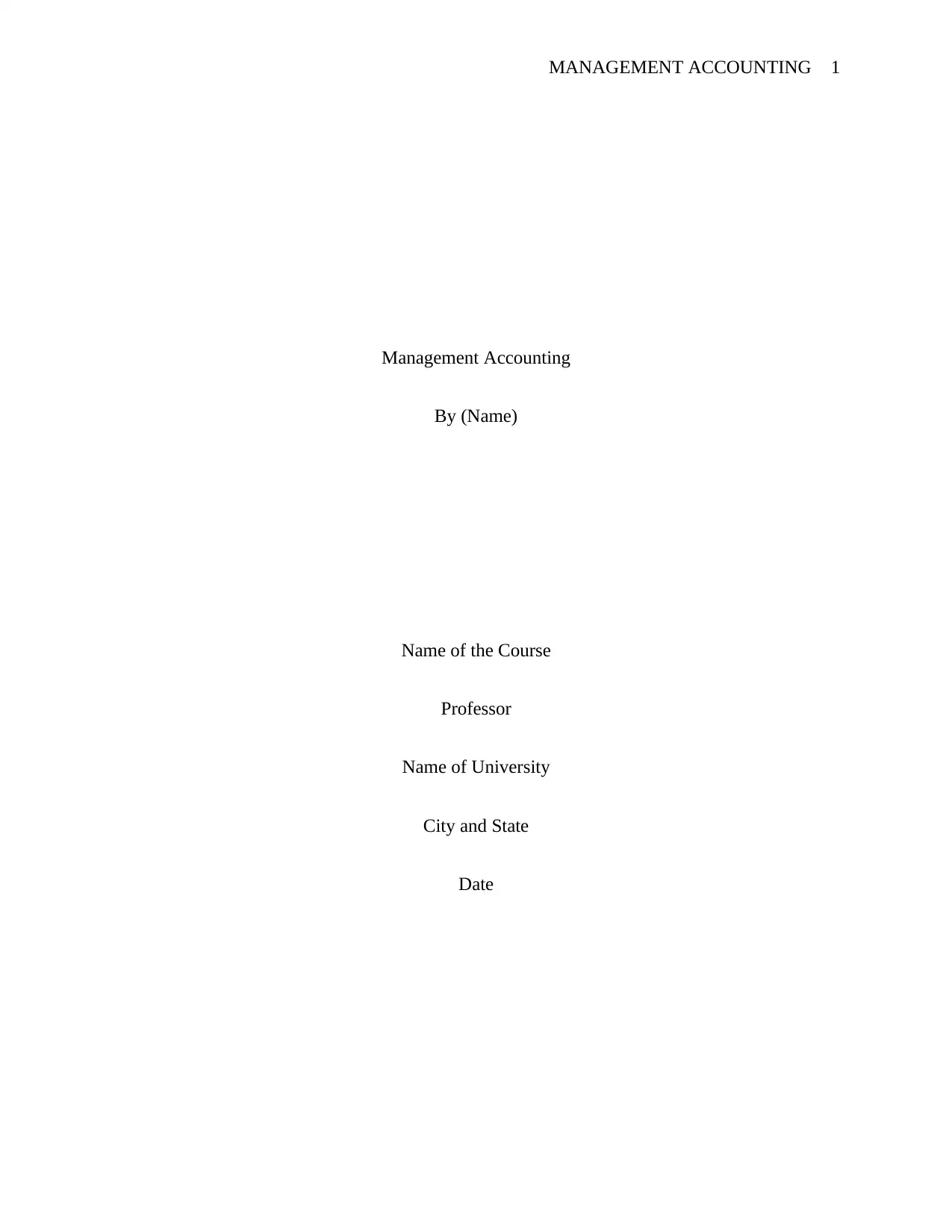
MANAGEMENT ACCOUNTING 1
Management Accounting
By (Name)
Name of the Course
Professor
Name of University
City and State
Date
Management Accounting
By (Name)
Name of the Course
Professor
Name of University
City and State
Date
Paraphrase This Document
Need a fresh take? Get an instant paraphrase of this document with our AI Paraphraser
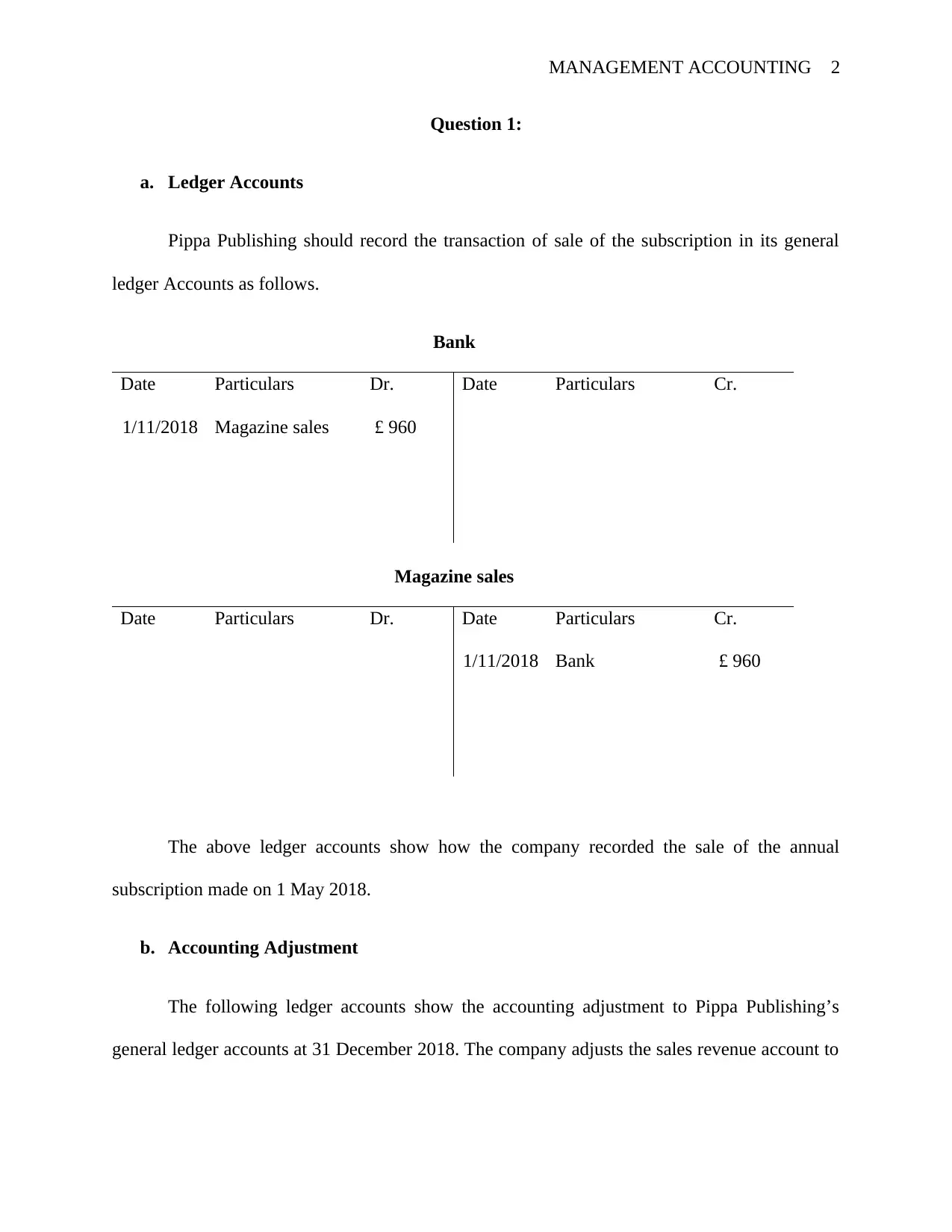
MANAGEMENT ACCOUNTING 2
Question 1:
a. Ledger Accounts
Pippa Publishing should record the transaction of sale of the subscription in its general
ledger Accounts as follows.
Bank
Date Particulars Dr. Date Particulars Cr.
1/11/2018 Magazine sales £ 960
Magazine sales
Date Particulars Dr. Date Particulars Cr.
1/11/2018 Bank £ 960
The above ledger accounts show how the company recorded the sale of the annual
subscription made on 1 May 2018.
b. Accounting Adjustment
The following ledger accounts show the accounting adjustment to Pippa Publishing’s
general ledger accounts at 31 December 2018. The company adjusts the sales revenue account to
Question 1:
a. Ledger Accounts
Pippa Publishing should record the transaction of sale of the subscription in its general
ledger Accounts as follows.
Bank
Date Particulars Dr. Date Particulars Cr.
1/11/2018 Magazine sales £ 960
Magazine sales
Date Particulars Dr. Date Particulars Cr.
1/11/2018 Bank £ 960
The above ledger accounts show how the company recorded the sale of the annual
subscription made on 1 May 2018.
b. Accounting Adjustment
The following ledger accounts show the accounting adjustment to Pippa Publishing’s
general ledger accounts at 31 December 2018. The company adjusts the sales revenue account to
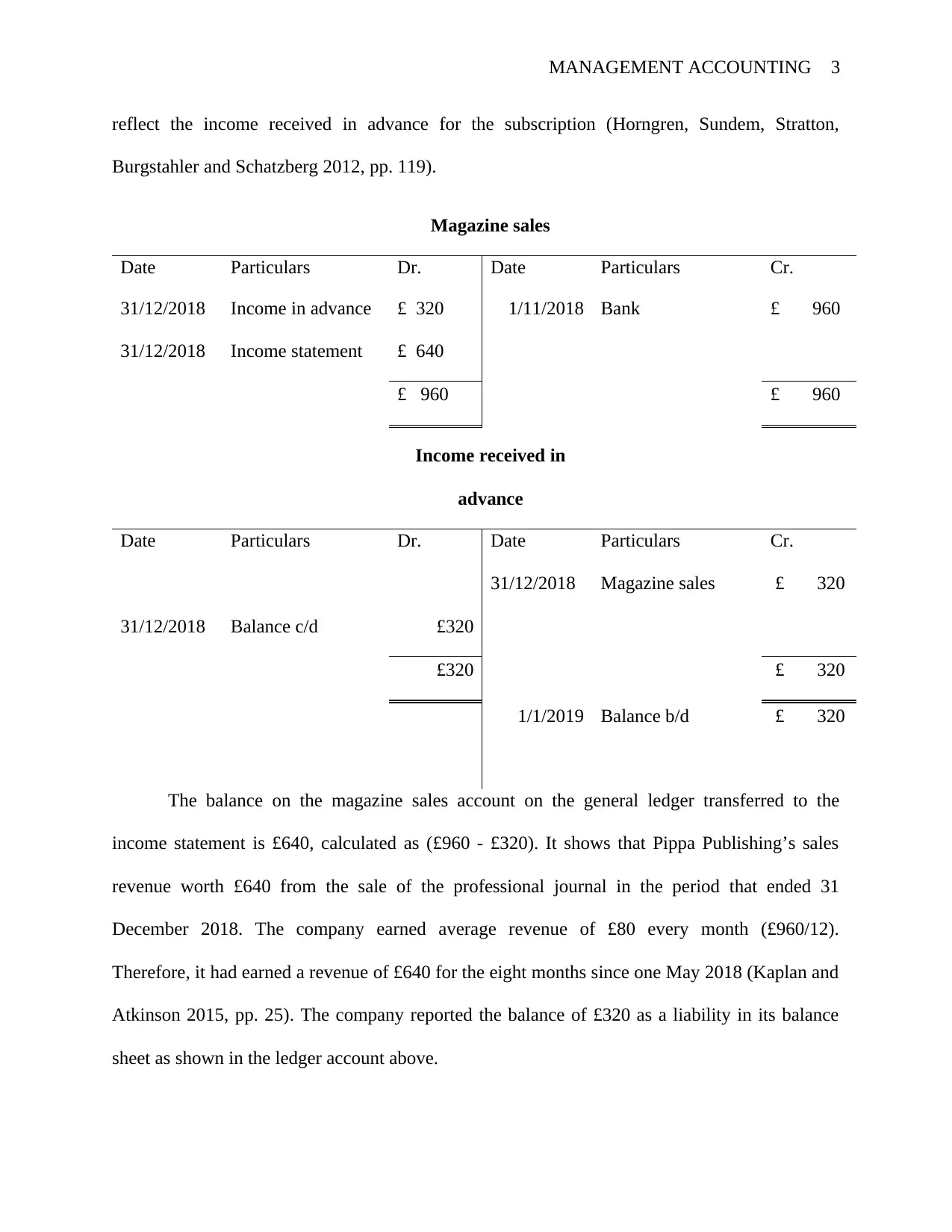
MANAGEMENT ACCOUNTING 3
reflect the income received in advance for the subscription (Horngren, Sundem, Stratton,
Burgstahler and Schatzberg 2012, pp. 119).
Magazine sales
Date Particulars Dr. Date Particulars Cr.
31/12/2018 Income in advance £ 320 1/11/2018 Bank £ 960
31/12/2018 Income statement £ 640
£ 960 £ 960
Income received in
advance
Date Particulars Dr. Date Particulars Cr.
31/12/2018 Magazine sales £ 320
31/12/2018 Balance c/d £320
£320 £ 320
1/1/2019 Balance b/d £ 320
The balance on the magazine sales account on the general ledger transferred to the
income statement is £640, calculated as (£960 - £320). It shows that Pippa Publishing’s sales
revenue worth £640 from the sale of the professional journal in the period that ended 31
December 2018. The company earned average revenue of £80 every month (£960/12).
Therefore, it had earned a revenue of £640 for the eight months since one May 2018 (Kaplan and
Atkinson 2015, pp. 25). The company reported the balance of £320 as a liability in its balance
sheet as shown in the ledger account above.
reflect the income received in advance for the subscription (Horngren, Sundem, Stratton,
Burgstahler and Schatzberg 2012, pp. 119).
Magazine sales
Date Particulars Dr. Date Particulars Cr.
31/12/2018 Income in advance £ 320 1/11/2018 Bank £ 960
31/12/2018 Income statement £ 640
£ 960 £ 960
Income received in
advance
Date Particulars Dr. Date Particulars Cr.
31/12/2018 Magazine sales £ 320
31/12/2018 Balance c/d £320
£320 £ 320
1/1/2019 Balance b/d £ 320
The balance on the magazine sales account on the general ledger transferred to the
income statement is £640, calculated as (£960 - £320). It shows that Pippa Publishing’s sales
revenue worth £640 from the sale of the professional journal in the period that ended 31
December 2018. The company earned average revenue of £80 every month (£960/12).
Therefore, it had earned a revenue of £640 for the eight months since one May 2018 (Kaplan and
Atkinson 2015, pp. 25). The company reported the balance of £320 as a liability in its balance
sheet as shown in the ledger account above.
⊘ This is a preview!⊘
Do you want full access?
Subscribe today to unlock all pages.

Trusted by 1+ million students worldwide
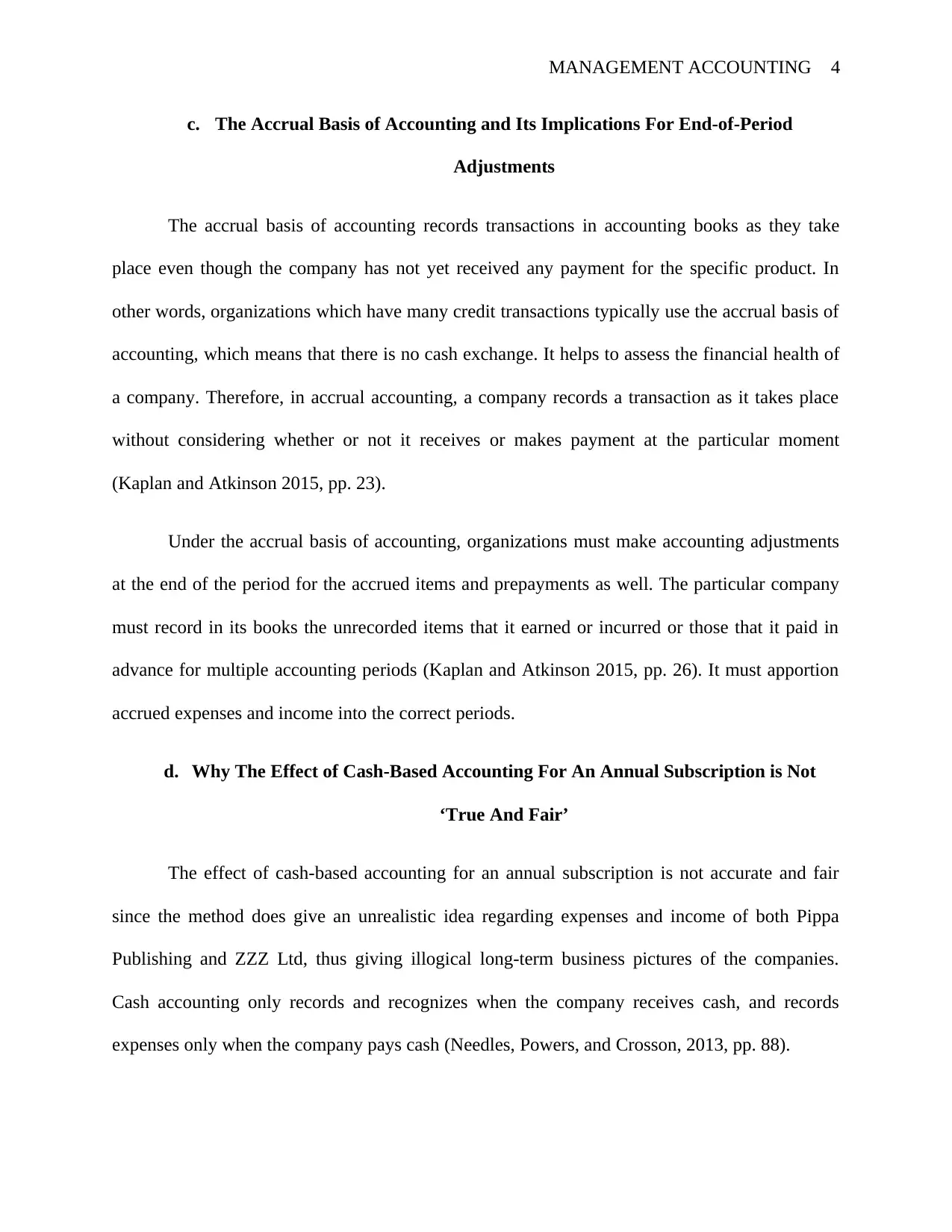
MANAGEMENT ACCOUNTING 4
c. The Accrual Basis of Accounting and Its Implications For End-of-Period
Adjustments
The accrual basis of accounting records transactions in accounting books as they take
place even though the company has not yet received any payment for the specific product. In
other words, organizations which have many credit transactions typically use the accrual basis of
accounting, which means that there is no cash exchange. It helps to assess the financial health of
a company. Therefore, in accrual accounting, a company records a transaction as it takes place
without considering whether or not it receives or makes payment at the particular moment
(Kaplan and Atkinson 2015, pp. 23).
Under the accrual basis of accounting, organizations must make accounting adjustments
at the end of the period for the accrued items and prepayments as well. The particular company
must record in its books the unrecorded items that it earned or incurred or those that it paid in
advance for multiple accounting periods (Kaplan and Atkinson 2015, pp. 26). It must apportion
accrued expenses and income into the correct periods.
d. Why The Effect of Cash-Based Accounting For An Annual Subscription is Not
‘True And Fair’
The effect of cash-based accounting for an annual subscription is not accurate and fair
since the method does give an unrealistic idea regarding expenses and income of both Pippa
Publishing and ZZZ Ltd, thus giving illogical long-term business pictures of the companies.
Cash accounting only records and recognizes when the company receives cash, and records
expenses only when the company pays cash (Needles, Powers, and Crosson, 2013, pp. 88).
c. The Accrual Basis of Accounting and Its Implications For End-of-Period
Adjustments
The accrual basis of accounting records transactions in accounting books as they take
place even though the company has not yet received any payment for the specific product. In
other words, organizations which have many credit transactions typically use the accrual basis of
accounting, which means that there is no cash exchange. It helps to assess the financial health of
a company. Therefore, in accrual accounting, a company records a transaction as it takes place
without considering whether or not it receives or makes payment at the particular moment
(Kaplan and Atkinson 2015, pp. 23).
Under the accrual basis of accounting, organizations must make accounting adjustments
at the end of the period for the accrued items and prepayments as well. The particular company
must record in its books the unrecorded items that it earned or incurred or those that it paid in
advance for multiple accounting periods (Kaplan and Atkinson 2015, pp. 26). It must apportion
accrued expenses and income into the correct periods.
d. Why The Effect of Cash-Based Accounting For An Annual Subscription is Not
‘True And Fair’
The effect of cash-based accounting for an annual subscription is not accurate and fair
since the method does give an unrealistic idea regarding expenses and income of both Pippa
Publishing and ZZZ Ltd, thus giving illogical long-term business pictures of the companies.
Cash accounting only records and recognizes when the company receives cash, and records
expenses only when the company pays cash (Needles, Powers, and Crosson, 2013, pp. 88).
Paraphrase This Document
Need a fresh take? Get an instant paraphrase of this document with our AI Paraphraser
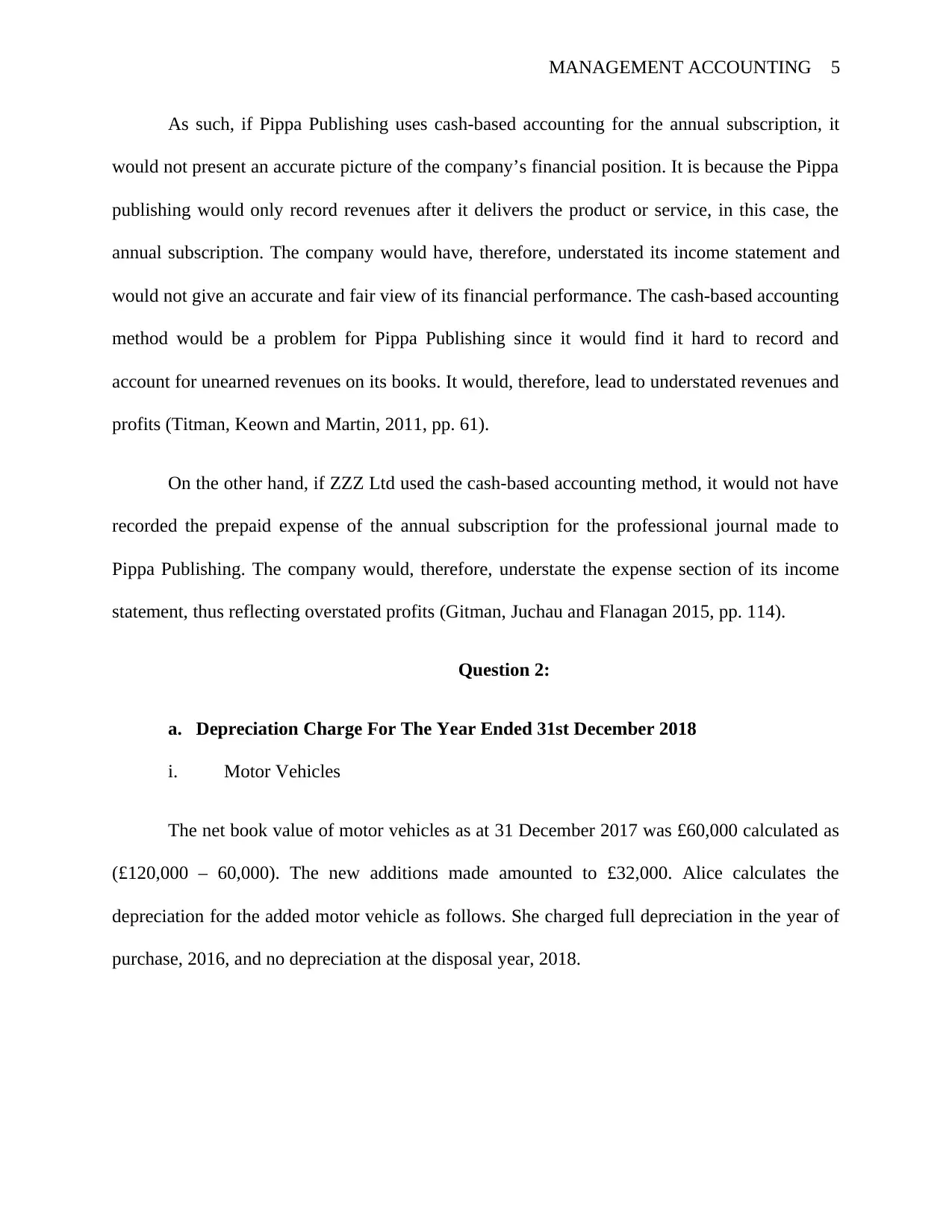
MANAGEMENT ACCOUNTING 5
As such, if Pippa Publishing uses cash-based accounting for the annual subscription, it
would not present an accurate picture of the company’s financial position. It is because the Pippa
publishing would only record revenues after it delivers the product or service, in this case, the
annual subscription. The company would have, therefore, understated its income statement and
would not give an accurate and fair view of its financial performance. The cash-based accounting
method would be a problem for Pippa Publishing since it would find it hard to record and
account for unearned revenues on its books. It would, therefore, lead to understated revenues and
profits (Titman, Keown and Martin, 2011, pp. 61).
On the other hand, if ZZZ Ltd used the cash-based accounting method, it would not have
recorded the prepaid expense of the annual subscription for the professional journal made to
Pippa Publishing. The company would, therefore, understate the expense section of its income
statement, thus reflecting overstated profits (Gitman, Juchau and Flanagan 2015, pp. 114).
Question 2:
a. Depreciation Charge For The Year Ended 31st December 2018
i. Motor Vehicles
The net book value of motor vehicles as at 31 December 2017 was £60,000 calculated as
(£120,000 – 60,000). The new additions made amounted to £32,000. Alice calculates the
depreciation for the added motor vehicle as follows. She charged full depreciation in the year of
purchase, 2016, and no depreciation at the disposal year, 2018.
As such, if Pippa Publishing uses cash-based accounting for the annual subscription, it
would not present an accurate picture of the company’s financial position. It is because the Pippa
publishing would only record revenues after it delivers the product or service, in this case, the
annual subscription. The company would have, therefore, understated its income statement and
would not give an accurate and fair view of its financial performance. The cash-based accounting
method would be a problem for Pippa Publishing since it would find it hard to record and
account for unearned revenues on its books. It would, therefore, lead to understated revenues and
profits (Titman, Keown and Martin, 2011, pp. 61).
On the other hand, if ZZZ Ltd used the cash-based accounting method, it would not have
recorded the prepaid expense of the annual subscription for the professional journal made to
Pippa Publishing. The company would, therefore, understate the expense section of its income
statement, thus reflecting overstated profits (Gitman, Juchau and Flanagan 2015, pp. 114).
Question 2:
a. Depreciation Charge For The Year Ended 31st December 2018
i. Motor Vehicles
The net book value of motor vehicles as at 31 December 2017 was £60,000 calculated as
(£120,000 – 60,000). The new additions made amounted to £32,000. Alice calculates the
depreciation for the added motor vehicle as follows. She charged full depreciation in the year of
purchase, 2016, and no depreciation at the disposal year, 2018.
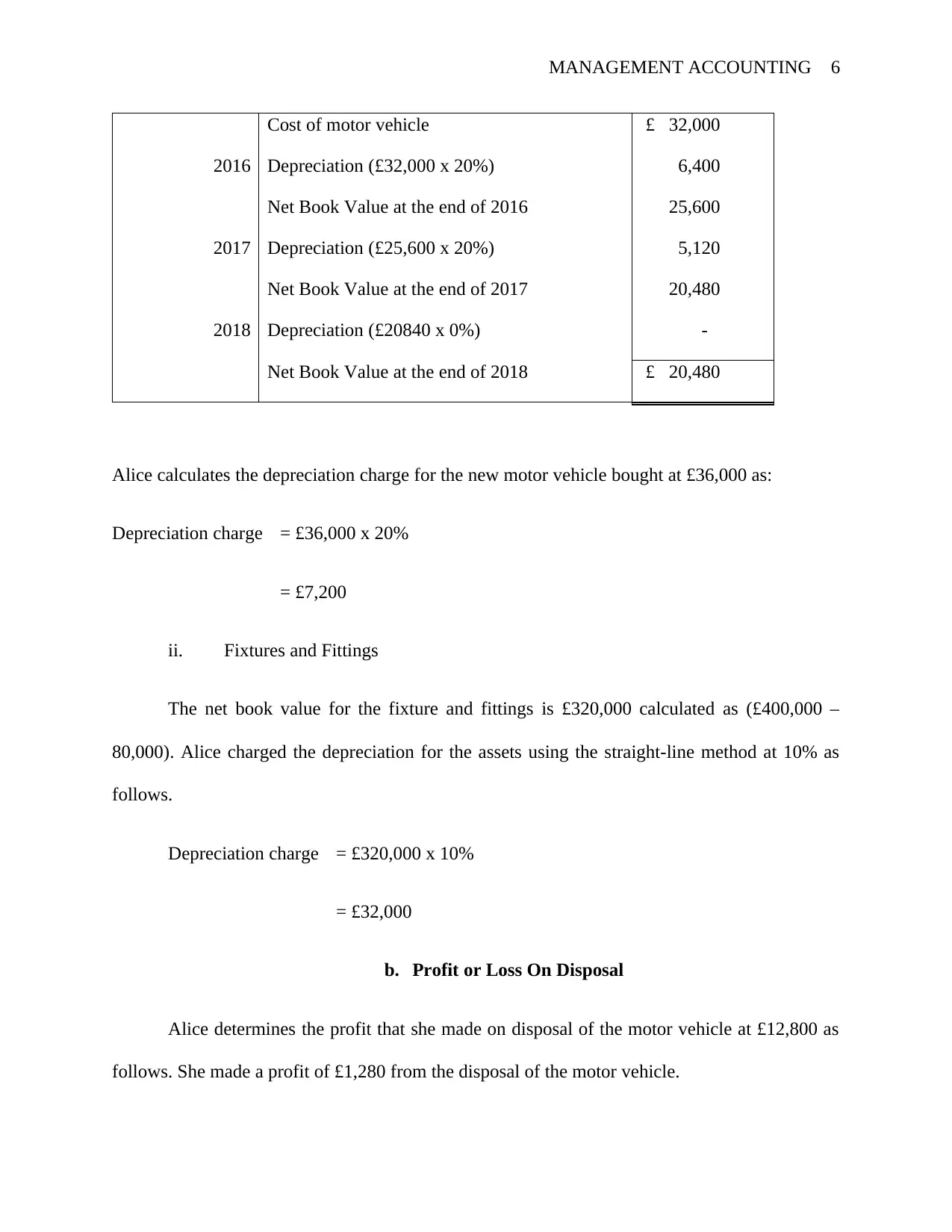
MANAGEMENT ACCOUNTING 6
Cost of motor vehicle £ 32,000
2016 Depreciation (£32,000 x 20%) 6,400
Net Book Value at the end of 2016 25,600
2017 Depreciation (£25,600 x 20%) 5,120
Net Book Value at the end of 2017 20,480
2018 Depreciation (£20840 x 0%) -
Net Book Value at the end of 2018 £ 20,480
Alice calculates the depreciation charge for the new motor vehicle bought at £36,000 as:
Depreciation charge = £36,000 x 20%
= £7,200
ii. Fixtures and Fittings
The net book value for the fixture and fittings is £320,000 calculated as (£400,000 –
80,000). Alice charged the depreciation for the assets using the straight-line method at 10% as
follows.
Depreciation charge = £320,000 x 10%
= £32,000
b. Profit or Loss On Disposal
Alice determines the profit that she made on disposal of the motor vehicle at £12,800 as
follows. She made a profit of £1,280 from the disposal of the motor vehicle.
Cost of motor vehicle £ 32,000
2016 Depreciation (£32,000 x 20%) 6,400
Net Book Value at the end of 2016 25,600
2017 Depreciation (£25,600 x 20%) 5,120
Net Book Value at the end of 2017 20,480
2018 Depreciation (£20840 x 0%) -
Net Book Value at the end of 2018 £ 20,480
Alice calculates the depreciation charge for the new motor vehicle bought at £36,000 as:
Depreciation charge = £36,000 x 20%
= £7,200
ii. Fixtures and Fittings
The net book value for the fixture and fittings is £320,000 calculated as (£400,000 –
80,000). Alice charged the depreciation for the assets using the straight-line method at 10% as
follows.
Depreciation charge = £320,000 x 10%
= £32,000
b. Profit or Loss On Disposal
Alice determines the profit that she made on disposal of the motor vehicle at £12,800 as
follows. She made a profit of £1,280 from the disposal of the motor vehicle.
⊘ This is a preview!⊘
Do you want full access?
Subscribe today to unlock all pages.

Trusted by 1+ million students worldwide
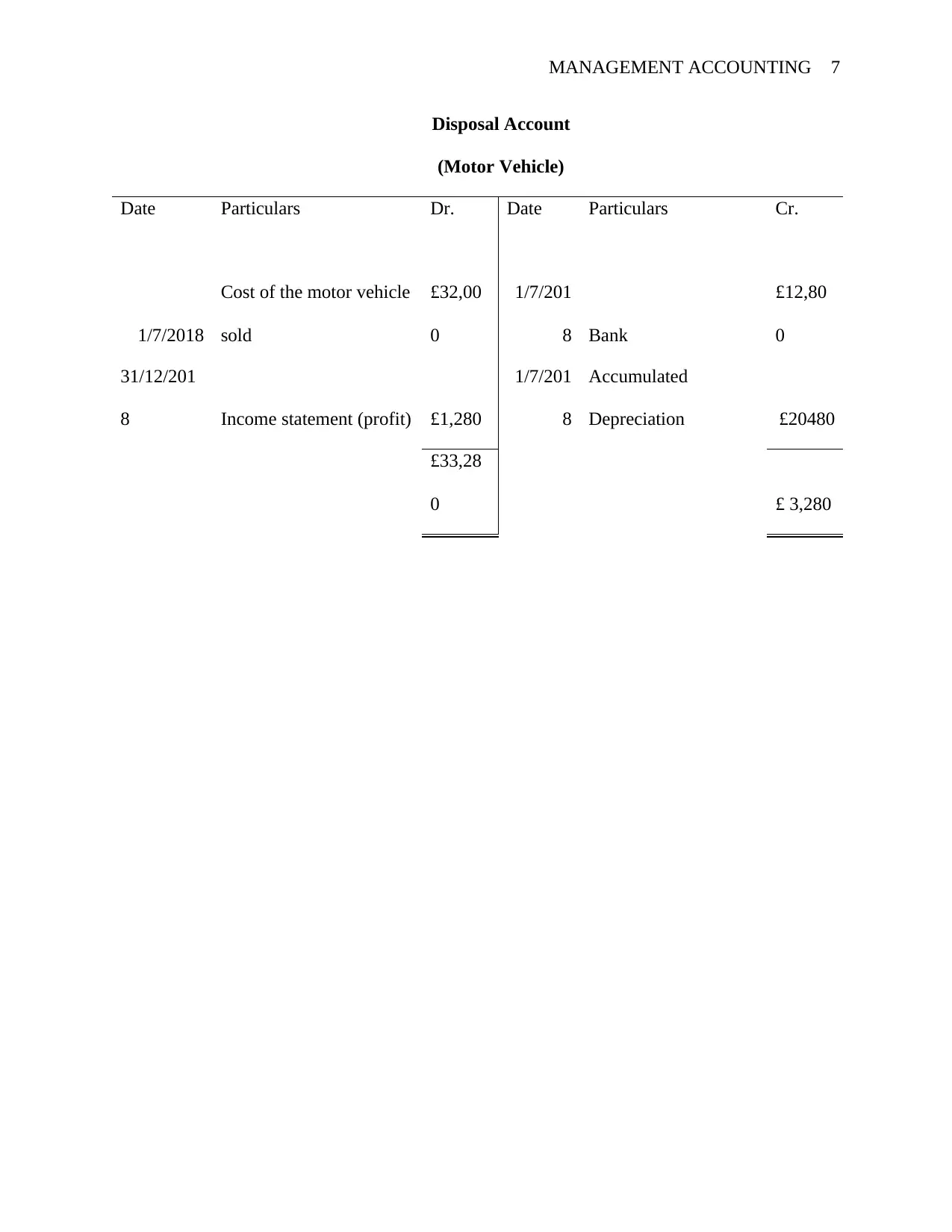
MANAGEMENT ACCOUNTING 7
Disposal Account
(Motor Vehicle)
Date Particulars Dr. Date Particulars Cr.
1/7/2018
Cost of the motor vehicle
sold
£32,00
0
1/7/201
8 Bank
£12,80
0
31/12/201
8 Income statement (profit) £1,280
1/7/201
8
Accumulated
Depreciation £20480
£33,28
0 £ 3,280
Disposal Account
(Motor Vehicle)
Date Particulars Dr. Date Particulars Cr.
1/7/2018
Cost of the motor vehicle
sold
£32,00
0
1/7/201
8 Bank
£12,80
0
31/12/201
8 Income statement (profit) £1,280
1/7/201
8
Accumulated
Depreciation £20480
£33,28
0 £ 3,280
Paraphrase This Document
Need a fresh take? Get an instant paraphrase of this document with our AI Paraphraser
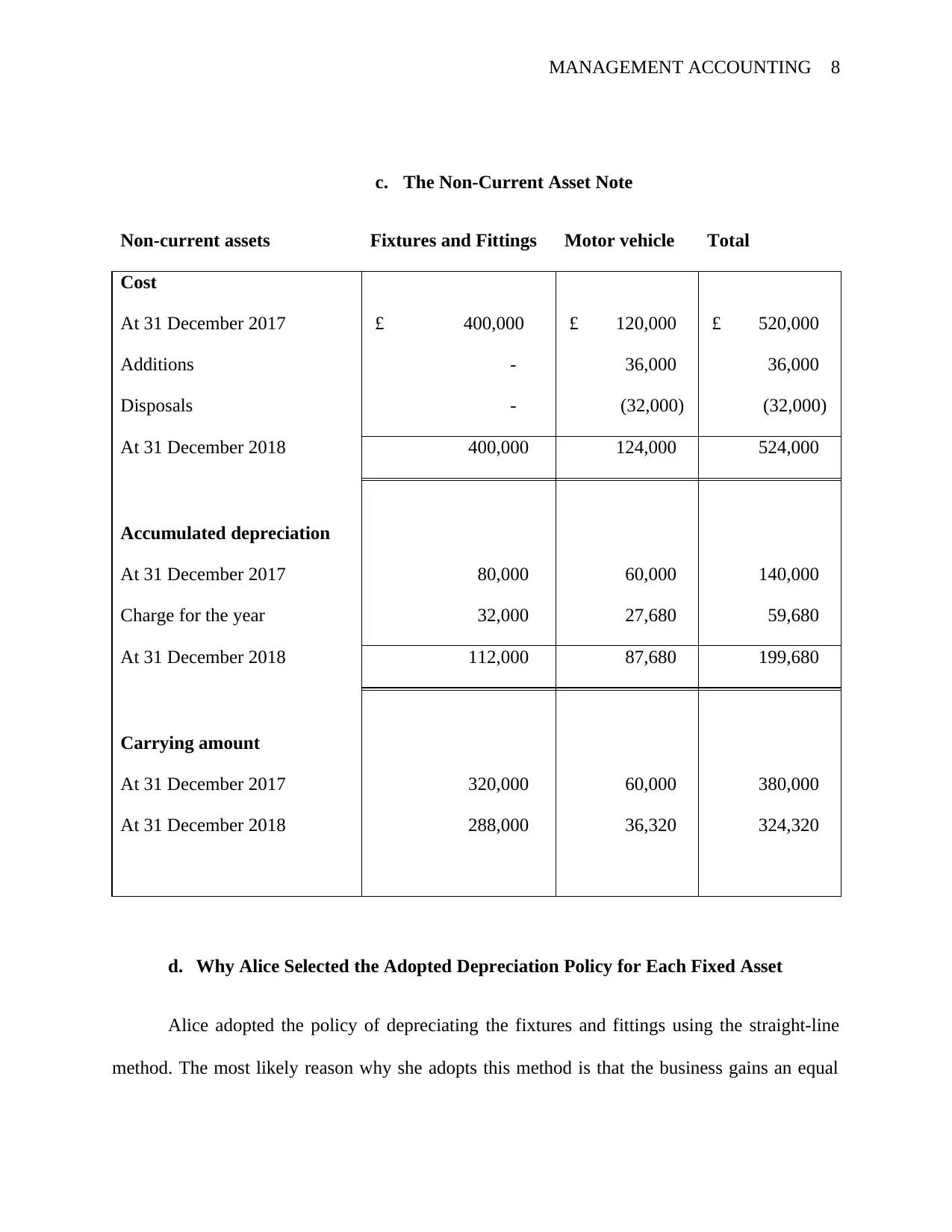
MANAGEMENT ACCOUNTING 8
c. The Non-Current Asset Note
Non-current assets Fixtures and Fittings Motor vehicle Total
Cost
At 31 December 2017 £ 400,000 £ 120,000 £ 520,000
Additions - 36,000 36,000
Disposals - (32,000) (32,000)
At 31 December 2018 400,000 124,000 524,000
Accumulated depreciation
At 31 December 2017 80,000 60,000 140,000
Charge for the year 32,000 27,680 59,680
At 31 December 2018 112,000 87,680 199,680
Carrying amount
At 31 December 2017 320,000 60,000 380,000
At 31 December 2018 288,000 36,320 324,320
d. Why Alice Selected the Adopted Depreciation Policy for Each Fixed Asset
Alice adopted the policy of depreciating the fixtures and fittings using the straight-line
method. The most likely reason why she adopts this method is that the business gains an equal
c. The Non-Current Asset Note
Non-current assets Fixtures and Fittings Motor vehicle Total
Cost
At 31 December 2017 £ 400,000 £ 120,000 £ 520,000
Additions - 36,000 36,000
Disposals - (32,000) (32,000)
At 31 December 2018 400,000 124,000 524,000
Accumulated depreciation
At 31 December 2017 80,000 60,000 140,000
Charge for the year 32,000 27,680 59,680
At 31 December 2018 112,000 87,680 199,680
Carrying amount
At 31 December 2017 320,000 60,000 380,000
At 31 December 2018 288,000 36,320 324,320
d. Why Alice Selected the Adopted Depreciation Policy for Each Fixed Asset
Alice adopted the policy of depreciating the fixtures and fittings using the straight-line
method. The most likely reason why she adopts this method is that the business gains an equal
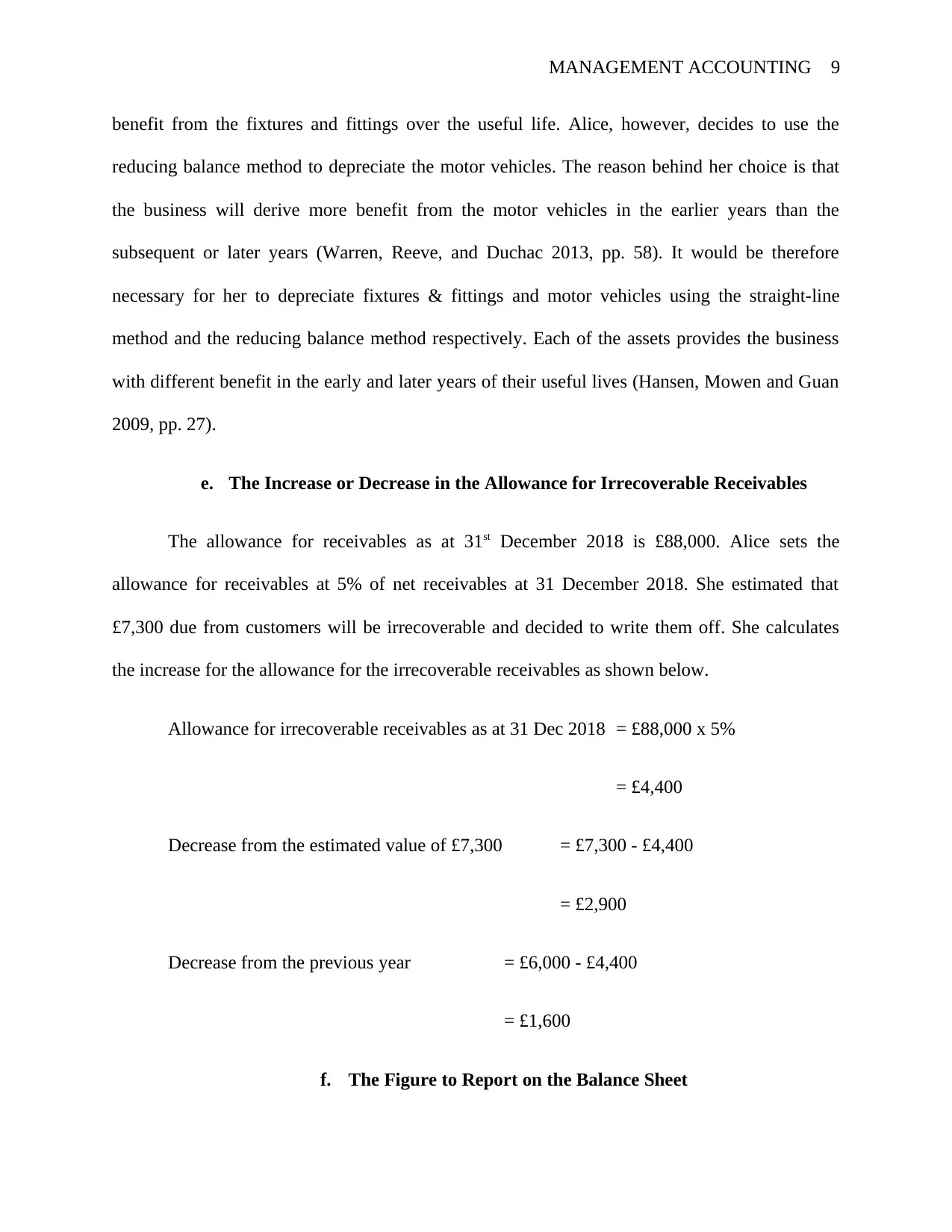
MANAGEMENT ACCOUNTING 9
benefit from the fixtures and fittings over the useful life. Alice, however, decides to use the
reducing balance method to depreciate the motor vehicles. The reason behind her choice is that
the business will derive more benefit from the motor vehicles in the earlier years than the
subsequent or later years (Warren, Reeve, and Duchac 2013, pp. 58). It would be therefore
necessary for her to depreciate fixtures & fittings and motor vehicles using the straight-line
method and the reducing balance method respectively. Each of the assets provides the business
with different benefit in the early and later years of their useful lives (Hansen, Mowen and Guan
2009, pp. 27).
e. The Increase or Decrease in the Allowance for Irrecoverable Receivables
The allowance for receivables as at 31st December 2018 is £88,000. Alice sets the
allowance for receivables at 5% of net receivables at 31 December 2018. She estimated that
£7,300 due from customers will be irrecoverable and decided to write them off. She calculates
the increase for the allowance for the irrecoverable receivables as shown below.
Allowance for irrecoverable receivables as at 31 Dec 2018 = £88,000 x 5%
= £4,400
Decrease from the estimated value of £7,300 = £7,300 - £4,400
= £2,900
Decrease from the previous year = £6,000 - £4,400
= £1,600
f. The Figure to Report on the Balance Sheet
benefit from the fixtures and fittings over the useful life. Alice, however, decides to use the
reducing balance method to depreciate the motor vehicles. The reason behind her choice is that
the business will derive more benefit from the motor vehicles in the earlier years than the
subsequent or later years (Warren, Reeve, and Duchac 2013, pp. 58). It would be therefore
necessary for her to depreciate fixtures & fittings and motor vehicles using the straight-line
method and the reducing balance method respectively. Each of the assets provides the business
with different benefit in the early and later years of their useful lives (Hansen, Mowen and Guan
2009, pp. 27).
e. The Increase or Decrease in the Allowance for Irrecoverable Receivables
The allowance for receivables as at 31st December 2018 is £88,000. Alice sets the
allowance for receivables at 5% of net receivables at 31 December 2018. She estimated that
£7,300 due from customers will be irrecoverable and decided to write them off. She calculates
the increase for the allowance for the irrecoverable receivables as shown below.
Allowance for irrecoverable receivables as at 31 Dec 2018 = £88,000 x 5%
= £4,400
Decrease from the estimated value of £7,300 = £7,300 - £4,400
= £2,900
Decrease from the previous year = £6,000 - £4,400
= £1,600
f. The Figure to Report on the Balance Sheet
⊘ This is a preview!⊘
Do you want full access?
Subscribe today to unlock all pages.

Trusted by 1+ million students worldwide
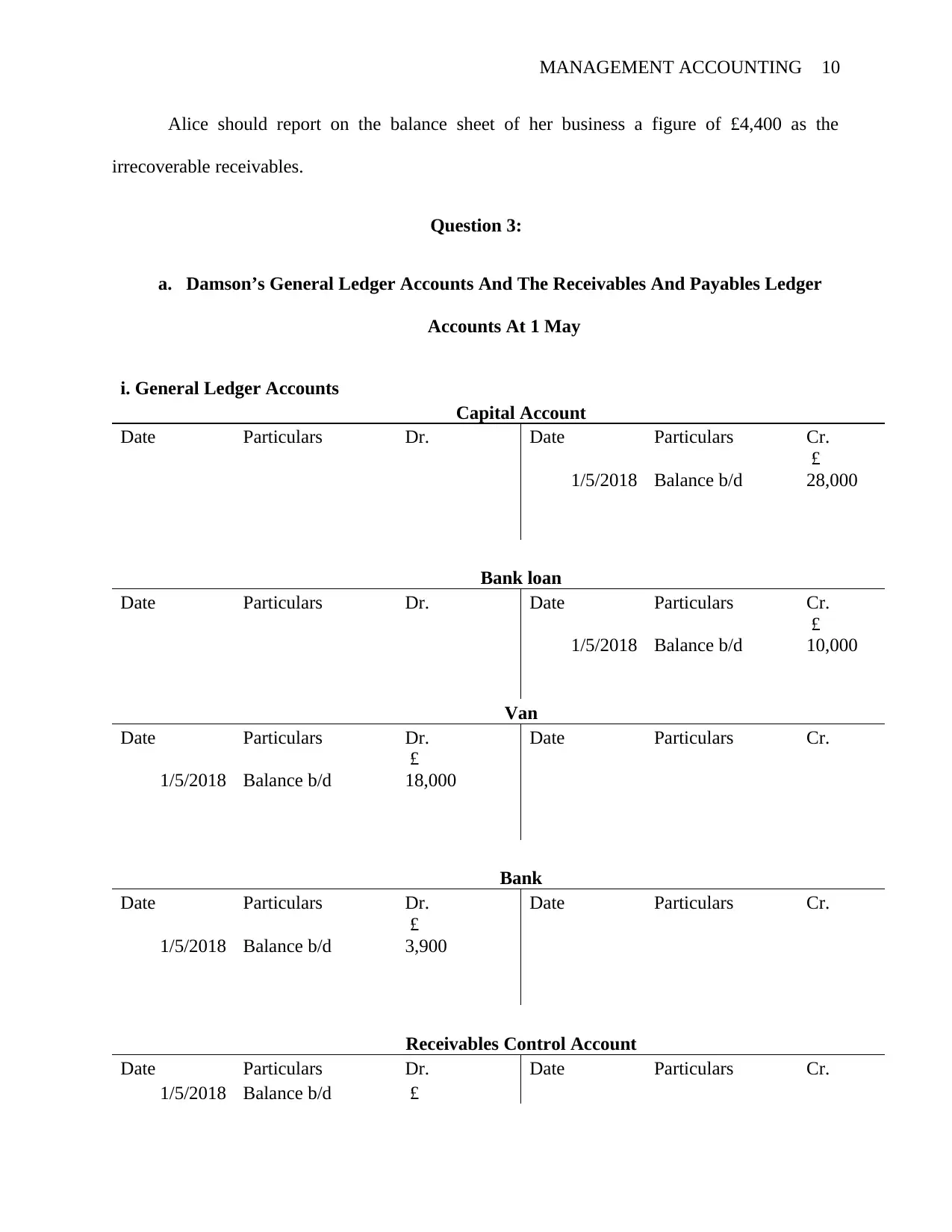
MANAGEMENT ACCOUNTING 10
Alice should report on the balance sheet of her business a figure of £4,400 as the
irrecoverable receivables.
Question 3:
a. Damson’s General Ledger Accounts And The Receivables And Payables Ledger
Accounts At 1 May
i. General Ledger Accounts
Capital Account
Date Particulars Dr. Date Particulars Cr.
1/5/2018 Balance b/d
£
28,000
Bank loan
Date Particulars Dr. Date Particulars Cr.
1/5/2018 Balance b/d
£
10,000
Van
Date Particulars Dr. Date Particulars Cr.
1/5/2018 Balance b/d
£
18,000
Bank
Date Particulars Dr. Date Particulars Cr.
1/5/2018 Balance b/d
£
3,900
Receivables Control Account
Date Particulars Dr. Date Particulars Cr.
1/5/2018 Balance b/d £
Alice should report on the balance sheet of her business a figure of £4,400 as the
irrecoverable receivables.
Question 3:
a. Damson’s General Ledger Accounts And The Receivables And Payables Ledger
Accounts At 1 May
i. General Ledger Accounts
Capital Account
Date Particulars Dr. Date Particulars Cr.
1/5/2018 Balance b/d
£
28,000
Bank loan
Date Particulars Dr. Date Particulars Cr.
1/5/2018 Balance b/d
£
10,000
Van
Date Particulars Dr. Date Particulars Cr.
1/5/2018 Balance b/d
£
18,000
Bank
Date Particulars Dr. Date Particulars Cr.
1/5/2018 Balance b/d
£
3,900
Receivables Control Account
Date Particulars Dr. Date Particulars Cr.
1/5/2018 Balance b/d £
Paraphrase This Document
Need a fresh take? Get an instant paraphrase of this document with our AI Paraphraser
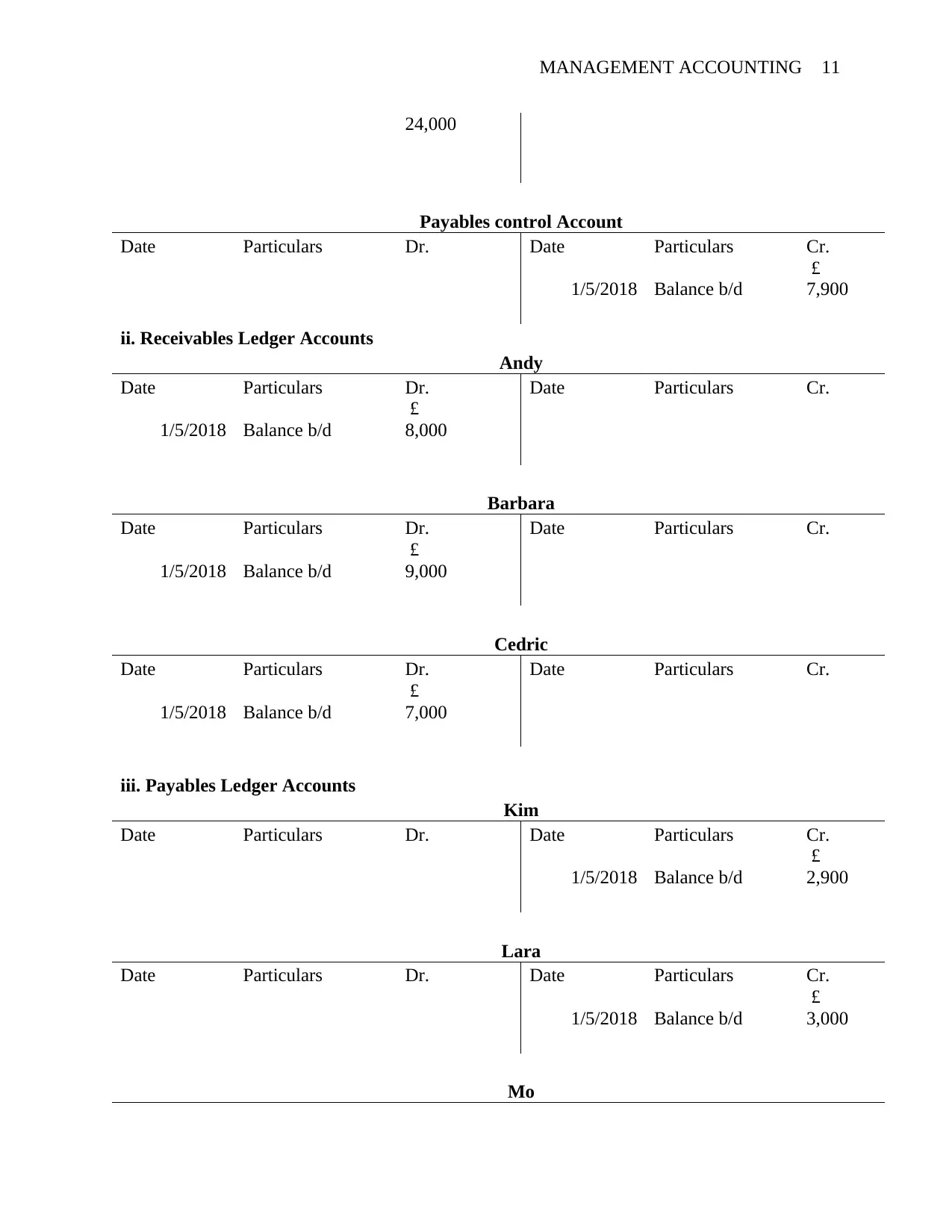
MANAGEMENT ACCOUNTING 11
24,000
Payables control Account
Date Particulars Dr. Date Particulars Cr.
1/5/2018 Balance b/d
£
7,900
ii. Receivables Ledger Accounts
Andy
Date Particulars Dr. Date Particulars Cr.
1/5/2018 Balance b/d
£
8,000
Barbara
Date Particulars Dr. Date Particulars Cr.
1/5/2018 Balance b/d
£
9,000
Cedric
Date Particulars Dr. Date Particulars Cr.
1/5/2018 Balance b/d
£
7,000
iii. Payables Ledger Accounts
Kim
Date Particulars Dr. Date Particulars Cr.
1/5/2018 Balance b/d
£
2,900
Lara
Date Particulars Dr. Date Particulars Cr.
1/5/2018 Balance b/d
£
3,000
Mo
24,000
Payables control Account
Date Particulars Dr. Date Particulars Cr.
1/5/2018 Balance b/d
£
7,900
ii. Receivables Ledger Accounts
Andy
Date Particulars Dr. Date Particulars Cr.
1/5/2018 Balance b/d
£
8,000
Barbara
Date Particulars Dr. Date Particulars Cr.
1/5/2018 Balance b/d
£
9,000
Cedric
Date Particulars Dr. Date Particulars Cr.
1/5/2018 Balance b/d
£
7,000
iii. Payables Ledger Accounts
Kim
Date Particulars Dr. Date Particulars Cr.
1/5/2018 Balance b/d
£
2,900
Lara
Date Particulars Dr. Date Particulars Cr.
1/5/2018 Balance b/d
£
3,000
Mo
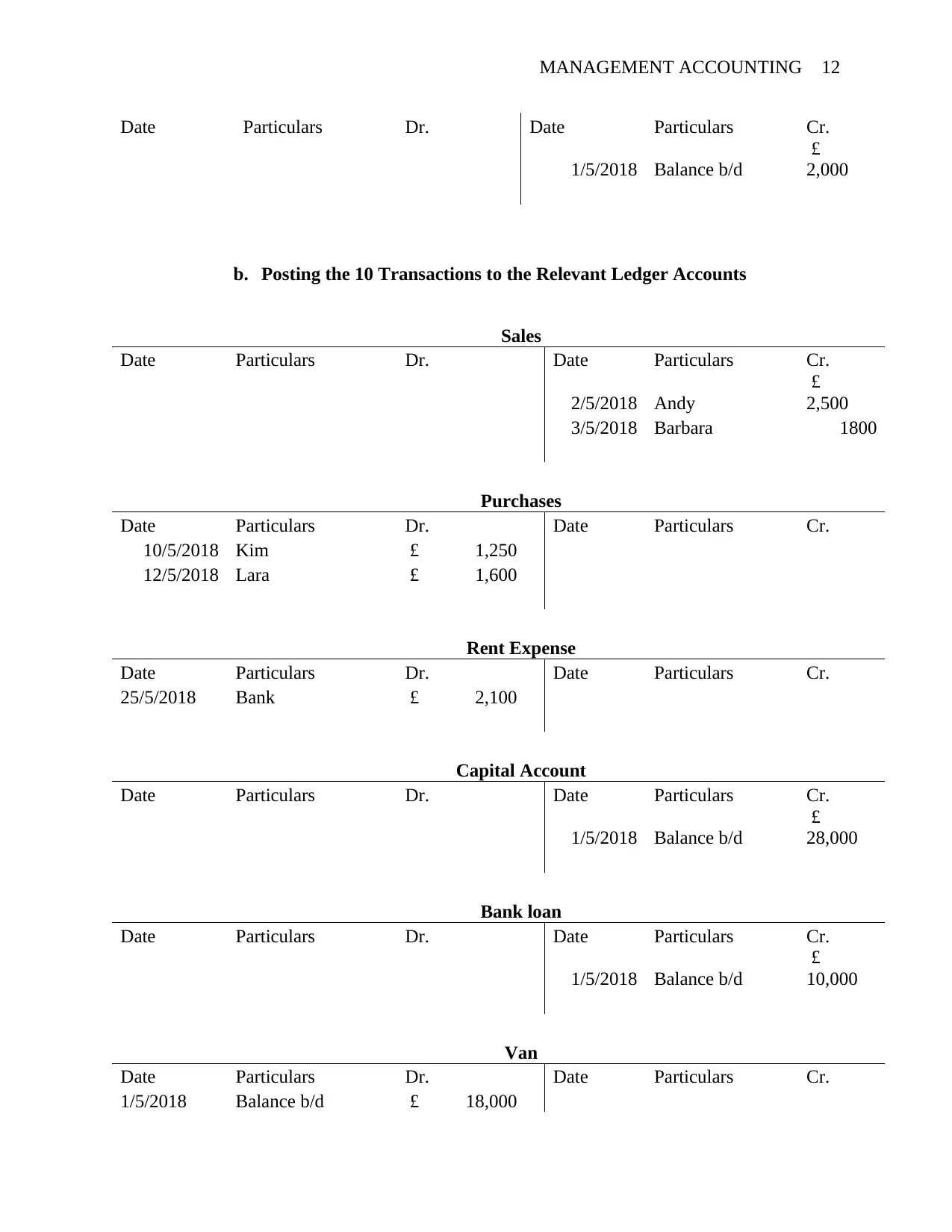
MANAGEMENT ACCOUNTING 12
Date Particulars Dr. Date Particulars Cr.
1/5/2018 Balance b/d
£
2,000
b. Posting the 10 Transactions to the Relevant Ledger Accounts
Sales
Date Particulars Dr. Date Particulars Cr.
2/5/2018 Andy
£
2,500
3/5/2018 Barbara 1800
Purchases
Date Particulars Dr. Date Particulars Cr.
10/5/2018 Kim £ 1,250
12/5/2018 Lara £ 1,600
Rent Expense
Date Particulars Dr. Date Particulars Cr.
25/5/2018 Bank £ 2,100
Capital Account
Date Particulars Dr. Date Particulars Cr.
1/5/2018 Balance b/d
£
28,000
Bank loan
Date Particulars Dr. Date Particulars Cr.
1/5/2018 Balance b/d
£
10,000
Van
Date Particulars Dr. Date Particulars Cr.
1/5/2018 Balance b/d £ 18,000
Date Particulars Dr. Date Particulars Cr.
1/5/2018 Balance b/d
£
2,000
b. Posting the 10 Transactions to the Relevant Ledger Accounts
Sales
Date Particulars Dr. Date Particulars Cr.
2/5/2018 Andy
£
2,500
3/5/2018 Barbara 1800
Purchases
Date Particulars Dr. Date Particulars Cr.
10/5/2018 Kim £ 1,250
12/5/2018 Lara £ 1,600
Rent Expense
Date Particulars Dr. Date Particulars Cr.
25/5/2018 Bank £ 2,100
Capital Account
Date Particulars Dr. Date Particulars Cr.
1/5/2018 Balance b/d
£
28,000
Bank loan
Date Particulars Dr. Date Particulars Cr.
1/5/2018 Balance b/d
£
10,000
Van
Date Particulars Dr. Date Particulars Cr.
1/5/2018 Balance b/d £ 18,000
⊘ This is a preview!⊘
Do you want full access?
Subscribe today to unlock all pages.

Trusted by 1+ million students worldwide
1 out of 21
Related Documents
Your All-in-One AI-Powered Toolkit for Academic Success.
+13062052269
info@desklib.com
Available 24*7 on WhatsApp / Email
![[object Object]](/_next/static/media/star-bottom.7253800d.svg)
Unlock your academic potential
Copyright © 2020–2025 A2Z Services. All Rights Reserved. Developed and managed by ZUCOL.





